Boating brings pleasure to millions of people. There is something about being on the water that people find both stimulating and relaxing. Some people may enjoy paddling a kayak along a river or across a lake. Others enjoy fishing from a small boat, towing water-skiers from a high-speed motorboat, or gliding across the water in a sailboat.
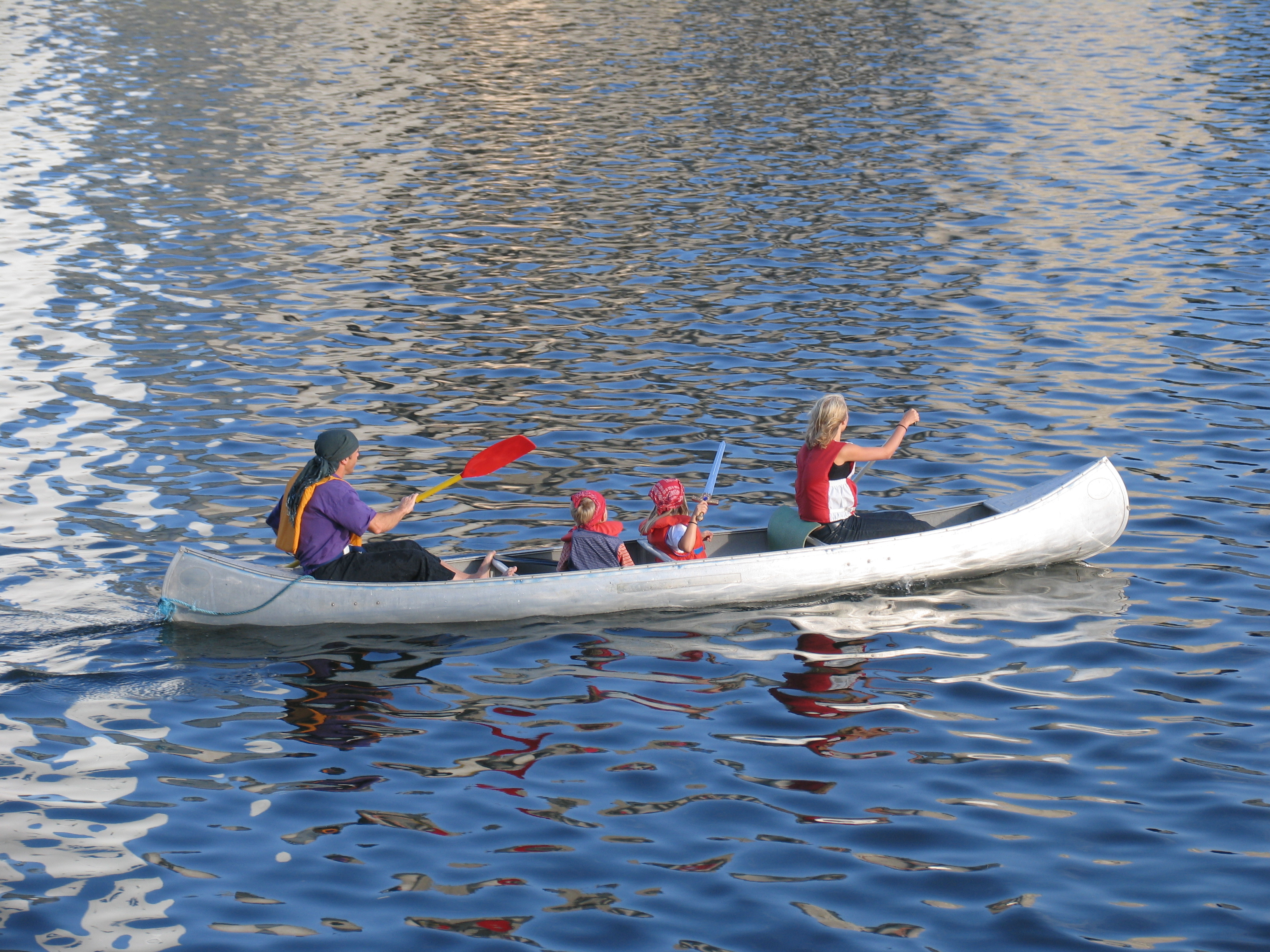
Unlike ships, most pleasure boats are not designed to travel across an ocean or similar large body of water. Pleasure craft can be powered by oars or paddles, a variety of small gasoline or diesel motors, or sails. In contrast, ships are powered by large diesel engines. For information on ships and commercial shipping, see the World Book article on Ship.
Types of boats
The smallest pleasure boats are canoes, kayaks, and small rowboats without engines or sails. They range in length from about 6 to 18 feet (1.8 to 5.5 meters). Boats that are powered by motors, sails, or both can run from about 9 feet (2.8 meters) to 150 feet (46 meters) or longer. A boat that is more than 50 feet (15 meters) long is often called a yacht. These crafts are often luxurious and include bunks, a galley (kitchen), and a head (toilet). Most pleasure boats are built of fiberglass, though aluminum and steel are also used.
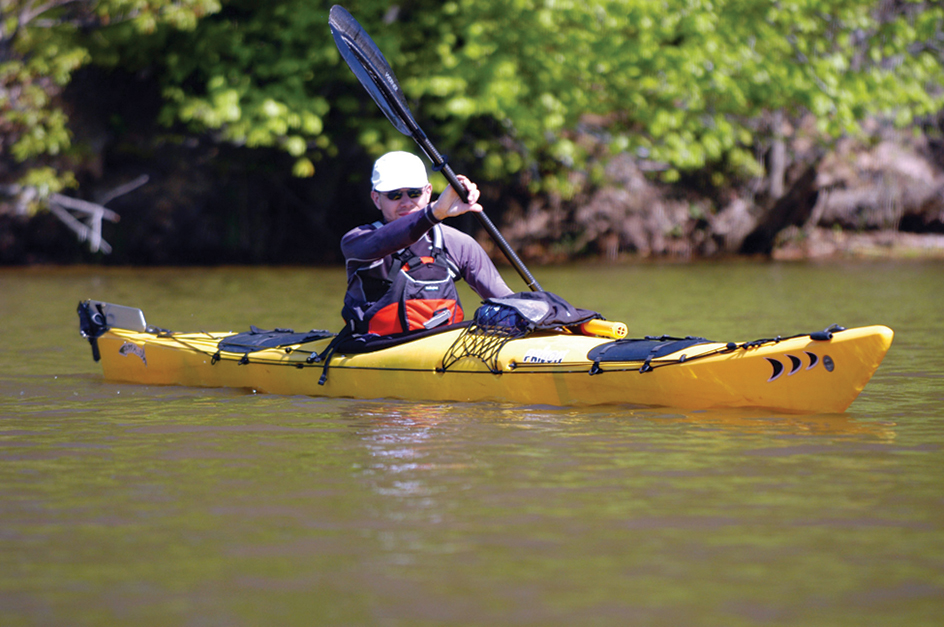
Motorboats.
Most of the boats used for pleasure boating are less than 26 feet (8 meters) in length. A majority are motorboats. They are powered either by an inboard engine, contained inside the boat’s hull, or an outboard motor, which is mounted on the stern (back) of the boat. Some boats combine both of these features, with the engine inside the hull and the driving gears and propeller within a unit at the stern. These designs are called an inboard/outboard (I/O) or sterndrive. Some boats are equipped with jet-propulsion units. On such boats, instead of driving a propeller, the engine draws water in through an intake and ejects it through a steerable nozzle at the stern. This engine design allows the boat to be operated in shallow water and lessens the risk of fishing lines or debris being caught in a propeller. 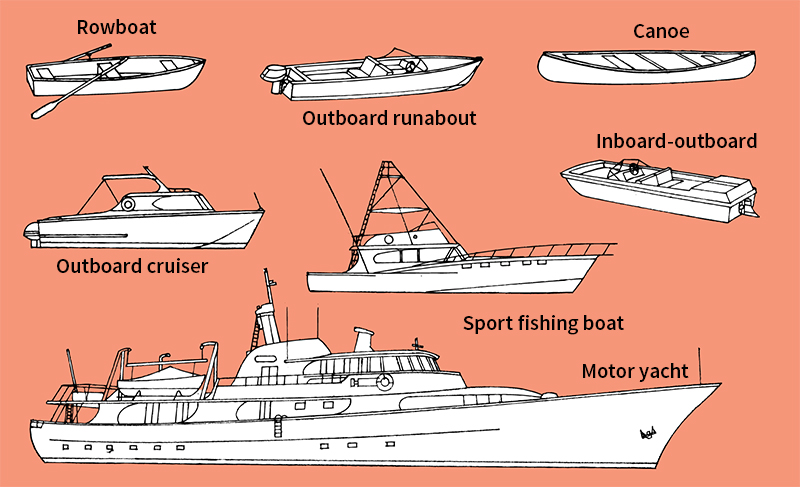
Among the most popular type of motorboats are water-skiing boats, fishing boats, and day-cruising boats called runabouts. They generally range from 16 to 30 feet (5 to 9 meters) in length. Those between 16 and 25 feet long are usually powered by outboard motors producing 40 to 75 horsepower (30 to 56 kilowatts). However, outboards that produce as much as 600 horsepower (440 kilowatts) are available for larger boats.
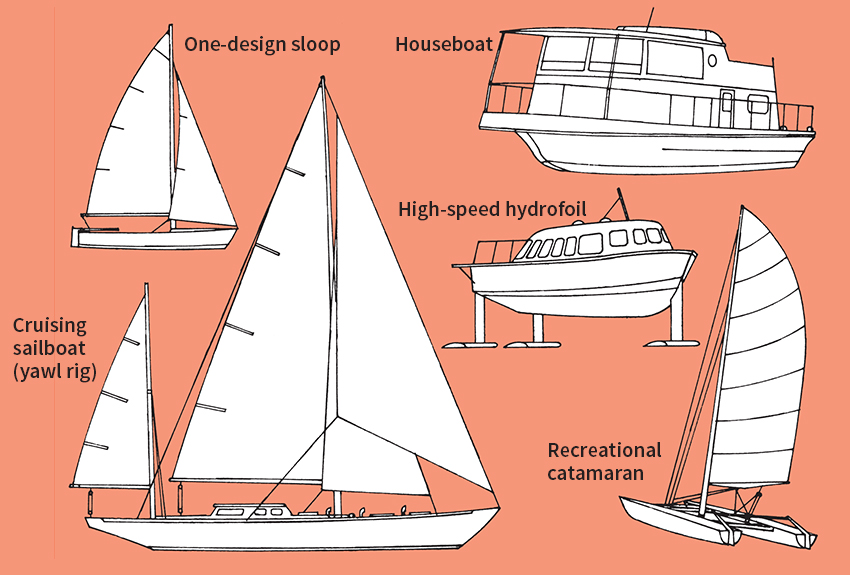
A number of motorboat designs with an overall length of at least 20 feet have a cabin in the forward part of the boat with one or two bunks. Unless a motorboat is exceptionally large, one person can operate it. Many motorboats more than 30 feet long have two inboard or outboard motors. This additional power enables the boat to travel at higher speeds. The twin propellers, rudders, or both also make this type of motorboat more maneuverable than a boat with only one propeller.
A luxurious motorboat with a length between 40 and 100 feet (12 and 30 meters) is often called a motor yacht. Similar craft that are more than 100 feet in length are often called super yachts, or mega yachts. Both types have several cabins with bunks, showers or bathtubs, a well-equipped galley, and dining and recreation areas both on deck and below. Generally, these yachts will have two engines and sophisticated electronic navigation equipment, including radar, radio telephones, and electronic satellite navigation and communications equipment. Such a yacht can cost tens of millions of dollars and is usually constructed of aluminum or fiberglass.
Sailboats,
like motorboats, can range from small craft less than 10 feet long to super yachts more than 150 feet in length. Smaller sailboats with no cabins are known as dinghies or daysailers. Larger sailboats, with sleeping cabins and such conveniences as heads and galleys, are known as cruising boats. Some sailboats are built only for racing, but most are designed for general-purpose sailing. No matter what its size, if the boat has one hull, its rig will determine the type of craft. For example, a sloop has one mast supporting a mainsail and one headsail (a sail in front of the mast). A boat with two headsails is a cutter. A schooner can have two or more masts of similar height. Other two-masted sailboats are the ketch and the yawl.

Some sailboats have two or three hulls. A boat with two hulls is called a catamaran. One with three hulls is called a trimaran. These craft are called multihulls and tend to be faster than monohull (single hull) boats. Multihull sailboats can range in length from small boats suitable for day sailing to large oceangoing vessels. Multihull sailboats are popular because they provide a great deal of comfort for their length. Some monohulls and multihulls can rise out of the water on curved fins called foils. When the sails provide enough power, the foils provide enough lift to elevate the hulls out of the water. The reduction in drag (friction) allows them to reach speeds once thought unreachable. Some sailboats have an auxiliary engine. An auxiliary engine can power the boat when there is not enough wind.
A houseboat is generally powered by an inboard engine. These craft are principally designed for use in sheltered waters, especially lakes and rivers. They feature large living and sleeping spaces that are designed into the hull and deck structure.
Another popular type of pleasure boat is the pontoon boat. Intended for sheltered waters, a pontoon boat has two hulls supporting a platform with room for comfortable seating, tables, and a grill.
A number of other power and sail designs are intended to perform work-related tasks. These designs include fishing boats, rescue boats, fire and patrol boats, and tugboats and tow boats.
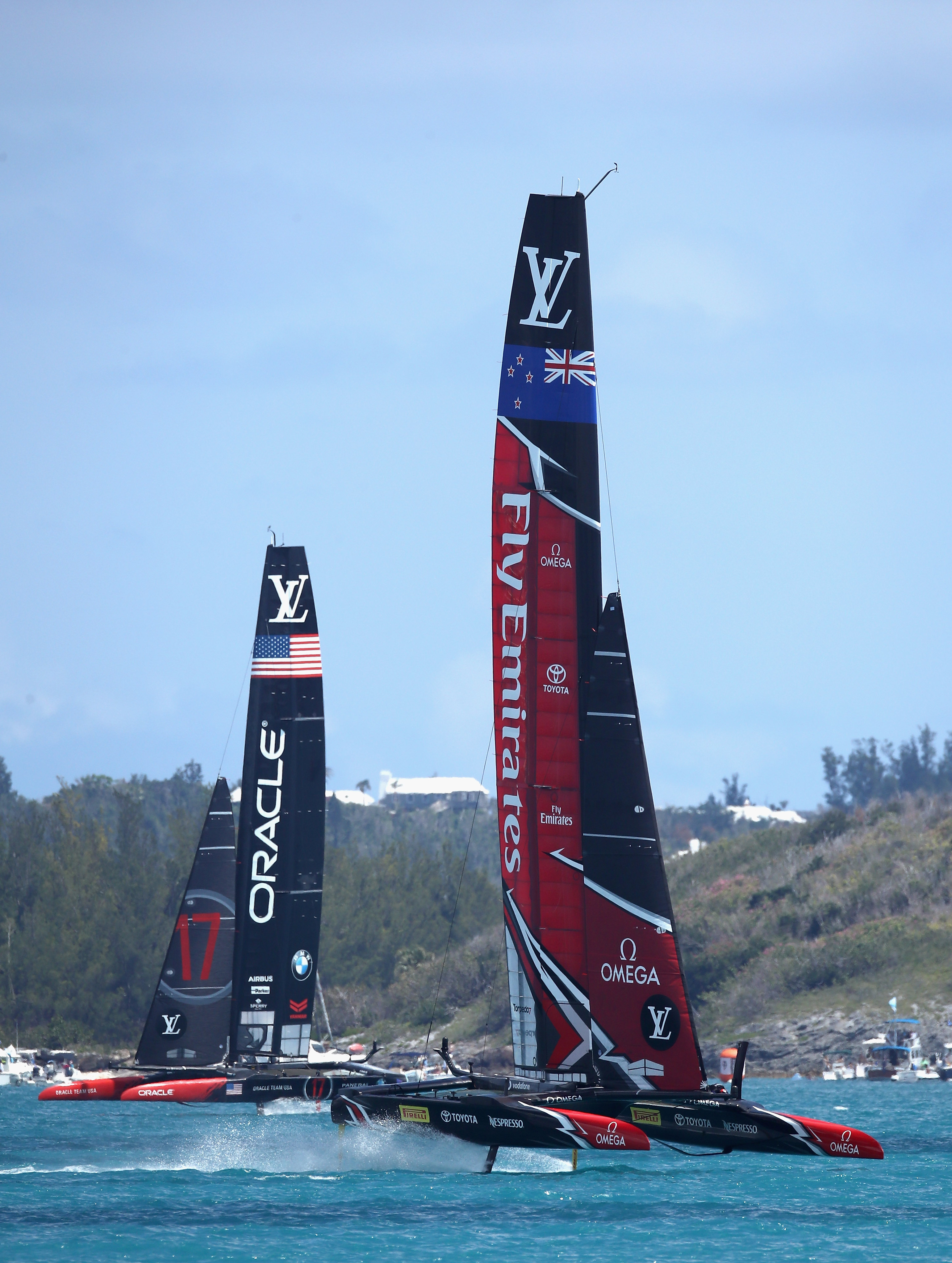
Boating safety
Boating regulations.
Boats must be handled properly, just like automobiles. Many countries have specific rules for the operation of motor-powered boats and for sailboats being driven by sails alone. In the United States, for example, the U.S. Coast Guard publishes the Navigation Rules, International-Inland. They apply to the operation of all vessels on the high seas and on all inland waters in the United States. The International Rules and the Inland Rules differ only slightly. They govern navigation lights, sound signals, distress signals, and rules for meeting and passing. Both sets of rules state that a vessel must be operated at a speed that always allows the operator to take action in time to avoid a collision.
Certain rules apply to motorboat operation. For example, when two boats approach each other head-on or almost head-on, both must alter course to pass each other on the port (left) side. When two boats are approaching each other at right angles, the boat that has the other on its starboard (right) side must alter course to keep clear of the other boat. Preferably, it should pass astern (behind) the boat on its right. These rules also apply to sailboats with auxiliary engines.
Boaters must follow other rules in addition to those concerning navigation. For example, each boat has its own carrying capacity. Overloading can cause a boat to capsize or become filled with water and become swamped. Boaters should also learn local rules concerning personal flotation devices (PFD’s), also known as lifejackets. These devices are designed to keep an individual afloat in the water. There are many kinds of PFD’s, and a boater is responsible for knowing what type is appropriate.
Many countries require boats to be registered with a government agency that will issue an identification number. This number must be displayed on both sides of the boat. Identification numbers help others identify a boat that may have been operated in a reckless fashion. They also can aid in tracing a lost or stolen craft.
A few countries, and some states in the United States, require operators of private pleasure boats to be licensed. If a boat is being operated for hire, however, some countries, including the United States, require that the operator of the craft be licensed by the Coast Guard or a similar agency. Numerous categories for operating licenses exist, depending upon the size of the craft, what work it is engaged in, and where it will be operated.
Buoys and other safety aids.
Most navigable waters are marked by fixed floating buoys of various shapes and colors, depending on where in the waterway they are. Colors and meaning can vary from country to country. In the United States, a boat entering a harbor from the sea will always find red buoys marking the right side of the channel and green buoys marking the channel’s left side. Some countries use red buoys on the left and green on the right. All red buoys in the United States have an even number, while green buoys have an odd number. When entering a harbor, the numbers on both sides of the channel will be sequential and will increase as they move farther away from the entrance.
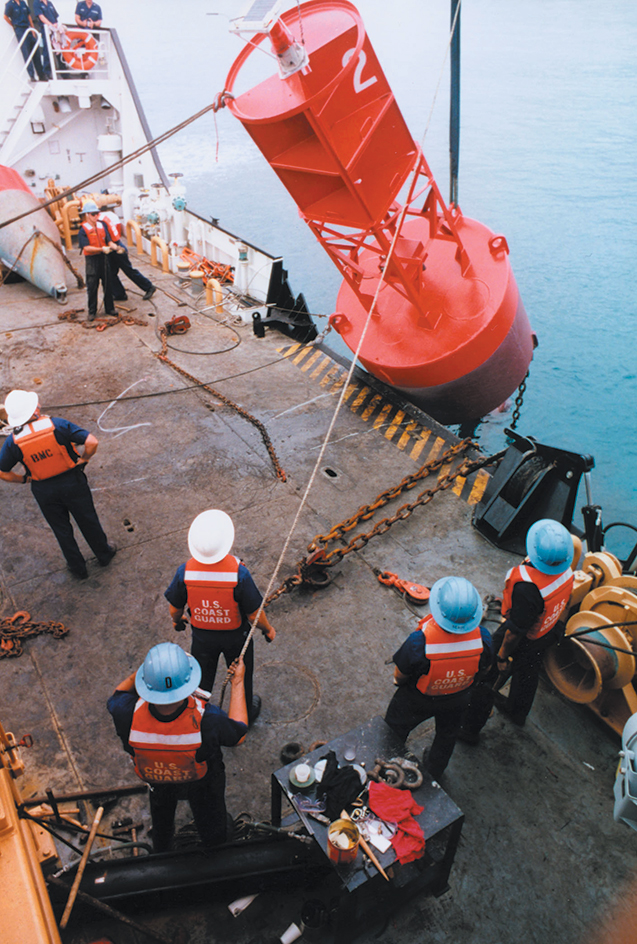
Some buoys have lights. Buoys may also have a horn, bell, or whistle as well as a radar reflector. Increasingly, buoys are being equipped with AIS (Automatic Identification System) devices that send a signal. The signal allows boats equipped with AIS receivers to locate the buoys clearly. All these devices allow buoys to be located more easily in reduced visibility. See Buoy.
Some areas have lighthouses that contain a powerful signal light and perhaps a foghorn. Both devices can help boaters locate their position at night or in reduced visibility. Some lighthouses as well as Coast Guard stations and yacht clubs may display visual signals that indicate future wind speed and weather conditions. Everyone who goes out on the water should be familiar with the meaning of these signals, particularly the single red pennant of a small craft advisory, a signal that warns of weather conditions dangerous to small boats. However, even if no signals are flying, sudden increases in wind speed can occur when squalls or thunderstorms are nearby. See Beacon ; Lighthouse .
Several on-board aids can help navigate a boat. Among the most important are a compass and charts (marine maps). Charts provide important navigational details, such as the depth of the water, location of sand banks and shoals (shallow places), and location of buoys. Most boaters today use electronic charts, usually in a GPS (Global Positioning System) device. GPS is a worldwide navigation system that uses radio signals broadcast by satellites. Electronic charts also can be used with smartphones and tablets. VHF radios incorporate weather channels that provide forecasts in a particular area. There are also many weather-related apps for a smartphone or tablet. Apps are software applications that run on mobile devices.
Boating safety programs.
Many organizations teach boating safety. Yacht clubs and community boating organizations often offer sailing and racing programs for both junior and adult sailors. National training organizations include the Australian Yachting Federation; the Canadian Power and Sail Squadrons; the Royal Yachting Association in the United Kingdom; and United States Sailing, BoatUS, and United States Power Squadrons in the United States.
History
Early boats.
The first boats were made from large logs that had been burned or scraped to make dugout canoes. Sails and outriggers were later added to those hulls. An outrigger is a float extending away from the hull to keep the craft from overturning.
Native Americans developed the canoe style of boat, which was light and easy to carry from one body of water to another. The word canoe is an Arawak word. The Arawak are an indigenous (native) Caribbean group. North American groups made the outer skin of a canoe from tree bark. The Inuit made seaworthy kayaks from animal skins. Pacific Islanders and African, Asian, and South American groups fashioned canoes and boats by attaching wooden planks with twine or constructing boats from reed, wicker, and other woven materials. These craft were used either for work or travel. Some made epic ocean crossings.
The development of pleasure boating.
Nobody really knows when pleasure boating began. Little about it was recorded until the mid-1600’s, when King Charles II introduced yachting into England. The Water Club of the Harbour of Cork was founded in Ireland in 1720 and is considered the first yacht club. It still exists and is known as the Royal Cork Yacht Club. The first British yacht club was the Royal Thames Yacht Club, founded in London in 1775. One of the first in the United States was the New York Yacht Club, formed in 1844.
The growth of boating.
Boating grew rapidly in popularity during the 1900’s as family income increased. Its popularity grew especially after World War II ended in 1945. During the 1950’s, the number of pleasure boats rose dramatically. Mass production methods for boat construction enabled more families to enjoy water-related activities at affordable cost. Pleasure boating increased most rapidly in countries with a long tradition of seafaring; with many navigable lakes and rivers; and with large numbers of harbors, marinas, and moorings. Boating became especially popular in Finland, New Zealand, Norway, and Sweden. Major boating countries today include Australia, Canada, Finland, New Zealand, Norway, Sweden, and the United States.
Boating today.
Improved engine technology, especially in the outboard field, has been an important part of boating growth. Engines have become more efficient, lighter, and more affordable. In the United States and many other countries, environmentally friendly four-stroke engines have replaced the older two-stroke machines in which oil and fuel were mixed together. Parts made of aluminum, plastic, and composite materials have made the outboard motor much lighter. Advances in battery technology have allowed less expensive electric outboard and inboard motors to gain in popularity. Similar improvements have been made in hull construction. Fiberglass is a heavy material, but it is easily molded into various shapes. The newest fiberglass hulls may have a foam core sandwiched between two layers of fiberglass to produce a stiffer and lighter hull.
The increased efficiency of automobiles and trucks has also helped the growth of boating because these vehicles tow many boats that are under 26 feet in length. A boat can now be taken out of the water, put on a trailer, transported, and stored in a garage or on a driveway. Local governments have also contributed to the growth of boating by constructing public launching facilities and marinas where boats can be tied up and left in a secure location.
